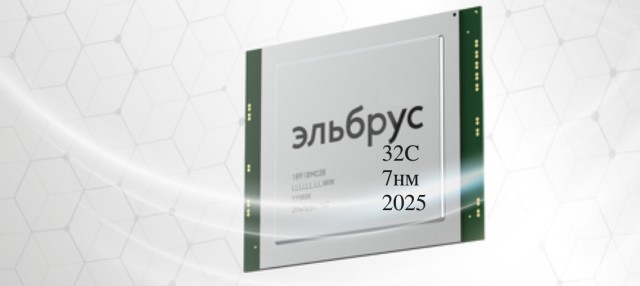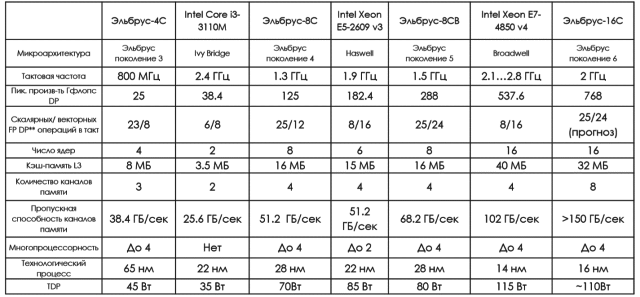ABOUT THE RUSSIAN ELBRUS PROCESSOR
February 21, 2021
I have to say that specific advertising policy of the former head of MCST Babayan in the form of periodic high-profile claims that the new processor Elbrus E2K is about to “break” Intel, permanently ending zilch, being zero from the beginning, has raised in me distrust of this company since the beginning of the 2000s. Moreover, when Babayan with a team of leading employees left for Intel in 2004, I thought that this was definitely all.
And yes, the company went quiet, and all the following years just quietly profited from something for the defence industry, almost without communicating with the outside world. It withdrew into itself. With long interruptions, it dryly posted new versions of processors on its website:
2005 – Elbrus-2000, which turned out to be a very simplified version of the E2K. Processor technology 130 nm, frequency 300 MHz, 1 core.
2010 and 2011 – Elbrus-S and Elbrus-2C+. Processor technology is 90 nm, the frequency is 500 MHz, 1 and 2 cores, respectively.
2014 – Elbrus-4C. 65 nm processor technology, frequency 800 MHz, 4 cores.
All of this was produced and financed for the defence industry, and so everything would have been sluggish and continued further, if not for the events of 2014. The fall in the ruble exchange rate and the sanctions of the western world have led to the need to have their own computing equipment not only in the military, but also in the civilian segment. But, I must say, the Medvedev government was particularly slow to do so.
The movement around the Elbrus processors intensified in an avalanche in 2020, exactly with the arrival of the Mishustin government. Probably just a coincidence… In general, it became clear that the government is planning something big, which was confirmed by the unprecedented government resolutions of the end of last year 2020. Why in the media it even slipped out, somehow sluggishly – it is not clear. Media leaders don’t understand the scale of what is happening?
I will start with the fact that from January 1st 2022, in order to obtain the status of Russian equipment and supply products to state structures, it is required to use a Russian central processor or controller in its composition (paragraph 2458 of 31.12.2020). Previously, this requirement was only applicable to data storage systems (paragraph 719 of 17.07.2015).
Nevertheless, the first and successful attempt to introduce Elbrus into civilian state structures nevertheless began in 2016, and since May 2017 the first data processing centre was introduced at the passport and visa service based on Elbrus-4C processors (back then about 130 servers, now already about 200 servers) instead of the IBM mainframes, which have been there since 2006, the cost of technical and service maintenance of which has suddenly increased. Thus, the cost of 1 year of maintenance of IBM mainframes has actually become comparable to the purchase of a data centre based on Elbrus.
From January 1st 2022, the requirement for a domestic processor or controller applies to almost any electronics, including ATMs, cash registers (processor or ad valorem part), I/O devices, monitors, peripherals (for example, printers) and “semiconductor storage devices” (controller in solid-state drives). There is also a requirement for quotas (paragraph 2013) for the purchase of radio-electronic equipment, and several other standards and proposals that are likely to become standards in the coming months.
Since the transition to a different architecture of the central processor in the equipment produced in Russia is often quite a complex process, measures of state support for companies developing products based on Russian processors (paragraph 109 and paragraph 529) have also been worked out. For example, the Ministry of Industry and Trade gives grants and subsidies for the creation of equipment with a Russian processor. The Ministry of Finance may also give similar grants, and there is a discussion about this. In the same way, the development of automatic design systems (CAD) and the development of electronic components and chips are supported. There is a program to subsidise consumers. And add to this the tax benefits for IT companies!
The scale of the measures taken indicates the seriousness of the state’s intentions to implement a massive transition of industry and state structures to domestic equipment. This can be treated in different ways (there will always be opponents), but at the moment it becomes obvious that a clear practical course has finally been taken on import substitution in radio electronics, and it is happening!
From the above, it follows that radio electronics engineers and programmers of system and application software have a new potentially very promising direction, which already needs to be actively studied, especially since several large successful projects have already been implemented on the basis of Elbrus processors:
In addition, a very high-load system for the Ministry of Internal Affairs (Center for the Automated Recording of Administrative Offences) is currently being deployed in Elbrus, where video analytics will be conducted in real time and there will be large databases. The system is expected to be completed by the end of 2021.
I think that now more and more new projects of this kind will actively appear.
Now companies that used to develop motherboards and build servers and other computing equipment based on x86 processors are actively expanding their solutions with lines based on the Elbrus processor. There are already about a dozen of them, and in the future there will be hundreds of them.
In connection with such activity of everything and everything, I think that Elbrus processors will soon catch up with Intel and AMD in performance, and maybe even approach them in cost due to the volume in the batch and taking into account the unprecedented measures of state support.
I think that our own factory is not far off. After all, in one of the drafts of the “strategy for the development of the electronic industry of the Russian Federation for the period up to 2030” for 2022-2025 there is the development of microelectronic products at the technological level of 28 nm and below, and development at the level of 14 nm and below, although the final document does not contain such specifics. There, with more general terms until 2030, the development and industrial development of silicon technologies for the production of electronic components with topological standards of 65-45 nm, 28 nm, 14-12 nm, 7-5 nm and subsequent production of products based on them, as well as the development of products based on silicon technology with a topological norm of 5 nm, followed by the production of products based on them at foreign factories and the transfer of production to the Russian Federation, are recorded. It is planned to create silicon factories operating in a “foundry” mode for the production of digital integrated circuits with topological standards of 28 nm, 14-12 nm, 7-5 nm.
I wonder if the norms of 5 nm will be relevant in 10 years? Perhaps, since science has almost reached the physical limit of microminiaturisation, and further reduction in size will affect the durability of such products. Perhaps productivity growth will take a different path.
Elektromozg
https://www.stalkerzone.org/about-the-russian-elbrus-processor/





 kvs
kvs